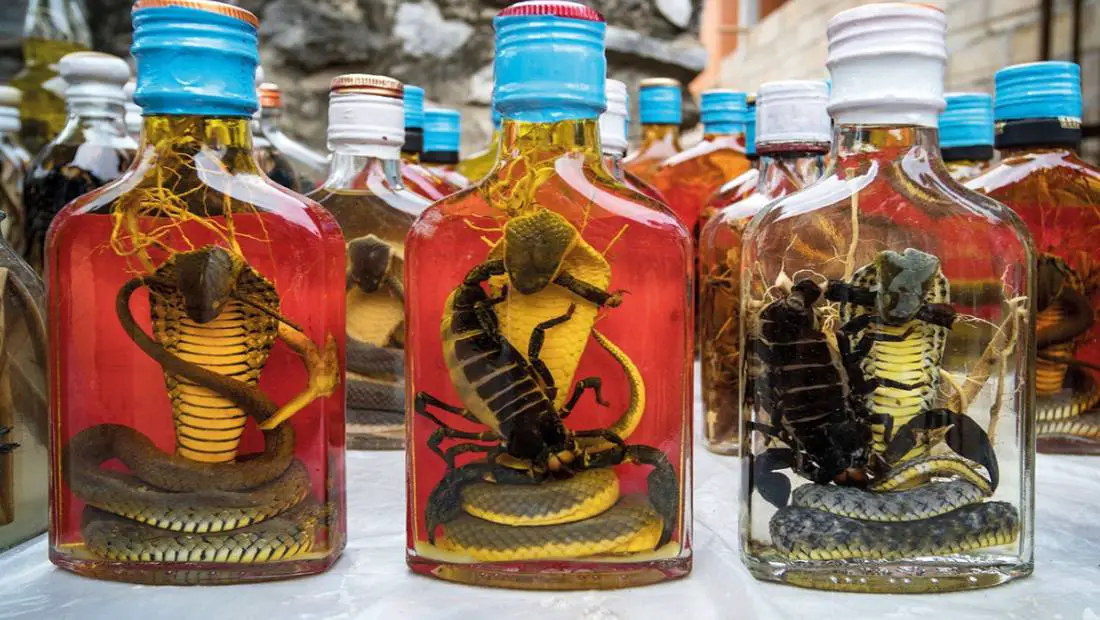If you are not living under a rock, you might have consumed or even are familiar with alcoholic beverages such as beer, wine, whiskey, or vodka. These quenchers are a star attraction at parties and gatherings, making merriment its nexus.
Brushing past these run-of-the-mill drinks, the land of Japan has reached newer heights and invented its own, rather peculiar drink, made of snake venom.
Does the consumer instantly collapse after sipping it, or do they experience a heightened state of tranquility, uncommon to conventional drinks? Read on to find out more.
The Infamous Habu Sake
Habu sake, also known as habushu or Okinawan Snake Wine is a fermented alcoholic beverage, native to Okinawa, Japan. Its title directly translates from the Japanese words “habu” and “sake” to snake wine or alcohol.
The beverage is made from fermented venom of the habu snake, closely related to rattlesnakes. The venom of these vipers is poisonous and fatal enough to partially paralyze or even cause death.
How Is Habu Sake Made?
This bizarre drink is made in distilleries by following two eccentric methods of production.
Crushed rice, honey and herbs are used to make awamori, a distilled liquid which gives the wine an amber tint while also eliminating the foul whiff, emitting from the decomposing snake.
The viper is then placed inside the jar, alive, to marinate with the juices and undo its venom, making it nonpoisonous. Drowning the snake in awamori and alcohol, kills it in a slow and painstaking pace, after which its venom is consumed as sake.
The other method of production is much more ruthless as compared to the first. The snake is submerged in an ice bath until it slides into unconsciousness, then its guts are extracted and later its wounds are sewn up.
Naturally, the snake revives consciousness only for a certain time, after which it dies of pain and agony. Then it is plunged into an ethanol bath to preserve its outer body for a month, and later kept in the jar containing its venom as an alcoholic beverage.
Most consumers look for jars containing the snake as an added pleasure to their taste buds and eyes and aesthetic. The bottles containing the snake are much more expensive than the ordinary ones.
How Is Habu Sake Consumed?
This odd drink is not surprisingly much in demand among Japanese drinkers. Habu sake is usually consumed along with supper at restaurants and bars mixed in a ratio of three parts of water and seven parts of alcohol in a traditional Japanese choku. Lemon and salt can also be added to the drink to enhance its flavor.
Is Habu Sake Safe To Drink?
You would most likely consider somebody voluntarily drinking snake venom to be not of a sound mind. But this is not the case in Japan regarding habu sake. Despite its lethal concoctions, habu sake is certified safe to consume.
Any remaining venom is de-poisoned and converted to alcohol during the ethanol procedure of the snake.
How Much Does Habu Sake Cost?
The price of one bottle of habu sake depends on size, volume and distributors. The most expensive bottle of habu sake was sold at 1,30,000 JPY, rounding about to 1,100 USD. The ones of lower quality and reach are priced at 8825 JPY.
Health Benefits Of Habu Sake
Strikingly enough, this oddball of a drink has a few health benefits. Allegedly it increases stamina and physical strength. It can also help patients with insomnia. However, these are not yet proved by science or medical health professionals and consumers are advised to drink Habu sake judiciously.
Is It Legal To Drink Outside Japan?
Due to its gruesome methods of preparation, habu sake is usually handled with caution overseas. It is not a cakewalk to slip this drink into the United State with the constant patrolling of the US Fish and Wildlife Service.
However, if you are lucky enough to gather proper certifications from legitimate sources, you could sneak in the Habu sake into the States.
If you ever visit Japan, do not worry about your dietary pleasures. This country houses many more impeccable cuisines which are tourist-friendly and obviously less bizarre than the snake wine, which surely will tingle your tastebuds.
With striking cuisines to picturesque locations, Southeast Asia is a pandora’s box that never ceases to amaze tourists


Yeah and you can’t have another service member bring it home 🤨